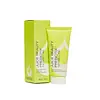What's inside
What's inside
 Key Ingredients
Key Ingredients

 Benefits
Benefits

 Concerns
Concerns

 Ingredients Side-by-side
Ingredients Side-by-side

Water
Skin ConditioningLactic Acid
BufferingPolylactic Acid
AbrasiveHelianthus Annuus Seed Oil
EmollientCetearyl Alcohol
EmollientPropanediol
SolventCeteareth-20
CleansingHamamelis Virginiana Water
AstringentPanax Ginseng Root Extract
EmollientCarica Papaya Fruit Extract
Skin ConditioningSaccharum Officinarum Extract
MoisturisingAcer Saccharum Extract
Skin ConditioningCucumis Sativus Fruit Extract
EmollientCitrus Aurantium Dulcis Fruit Extract
MaskingCitrus Limon Fruit Extract
MaskingVaccinium Myrtillus Fruit Extract
Skin ConditioningHydroxyethylcellulose
Emulsion StabilisingPolyglyceryl-3 Cocoate
EmulsifyingButylene Glycol
HumectantMaltooligosyl Glucoside
Skin ConditioningGlyceryl Stearate
EmollientPEG-100 Stearate
Caprylic/Capric Triglyceride
MaskingDipentaerythrityl Tri-Polyhydroxystearate
EmollientHydrogenated Starch Hydrolysate
HumectantPhenoxyethanol
PreservativeCaprylyl Glycol
EmollientSodium Hydroxide
BufferingXanthan Gum
EmulsifyingPolyglyceryl-4 Caprate
EmulsifyingPolyglyceryl-6 Caprylate
EmulsifyingPolyglyceryl-6 Ricinoleate
EmulsifyingPentylene Glycol
Skin ConditioningSorbic Acid
PreservativeHydroxyphenyl Propamidobenzoic Acid
Skin ConditioningAscorbyl Palmitate
AntioxidantBenzoic Acid
MaskingTocopherol
AntioxidantWater, Lactic Acid, Polylactic Acid, Helianthus Annuus Seed Oil, Cetearyl Alcohol, Propanediol, Ceteareth-20, Hamamelis Virginiana Water, Panax Ginseng Root Extract, Carica Papaya Fruit Extract, Saccharum Officinarum Extract, Acer Saccharum Extract, Cucumis Sativus Fruit Extract, Citrus Aurantium Dulcis Fruit Extract, Citrus Limon Fruit Extract, Vaccinium Myrtillus Fruit Extract, Hydroxyethylcellulose, Polyglyceryl-3 Cocoate, Butylene Glycol, Maltooligosyl Glucoside, Glyceryl Stearate, PEG-100 Stearate, Caprylic/Capric Triglyceride, Dipentaerythrityl Tri-Polyhydroxystearate, Hydrogenated Starch Hydrolysate, Phenoxyethanol, Caprylyl Glycol, Sodium Hydroxide, Xanthan Gum, Polyglyceryl-4 Caprate, Polyglyceryl-6 Caprylate, Polyglyceryl-6 Ricinoleate, Pentylene Glycol, Sorbic Acid, Hydroxyphenyl Propamidobenzoic Acid, Ascorbyl Palmitate, Benzoic Acid, Tocopherol
Aloe Barbadensis Leaf Juice
Skin ConditioningPyrus Malus Juice
Skin ConditioningVitis Vinifera
MaskingGlycerin
HumectantCellulose
AbsorbentCaprylic/Capric Triglyceride
MaskingCetyl Esters
EmollientStearyl Alcohol
EmollientHelianthus Annuus Seed Oil
EmollientGlyceryl Stearate
EmollientHydroxypropyl Starch Phosphate
Microcrystalline Cellulose
AbsorbentDiheptyl Succinate
EmollientGluconolactone
Skin ConditioningTartaric Acid
BufferingIris Pallida Leaf Cell Extract
AntioxidantGlycolic Acid
BufferingPhytic Acid
Hydrolyzed Hyaluronic Acid
HumectantSalix Alba Bark Extract
AstringentLactobacillus
Skin ConditioningLactobacillus Ferment
Skin ConditioningHydrolyzed Viola Tricolor Extract
Skin ProtectingMicrocitrus Australasica Fruit Extract
Lactobacillus Ferment Lysate
Skin ConditioningJuniperus Virginiana Oil
MaskingCapryloyl Glycerin
Citrus Aurantium Dulcis Peel Oil
MaskingSalvia Sclarea Oil
MaskingCoco-Glucoside
CleansingPanthenyl Triacetate
Xanthan Gum
EmulsifyingTetrasodium Glutamate Diacetate
Hydroxypropylcellulose
EmulsifyingSodium Hydroxide
BufferingTriethyl Citrate
MaskingCalcium Gluconate
HumectantCocos Nucifera Fruit Extract
EmollientEthyl Linalool
MaskingSodium Benzoate
MaskingLimonene
PerfumingAloe Barbadensis Leaf Juice, Pyrus Malus Juice, Vitis Vinifera, Glycerin, Cellulose, Caprylic/Capric Triglyceride, Cetyl Esters, Stearyl Alcohol, Helianthus Annuus Seed Oil, Glyceryl Stearate, Hydroxypropyl Starch Phosphate, Microcrystalline Cellulose, Diheptyl Succinate, Gluconolactone, Tartaric Acid, Iris Pallida Leaf Cell Extract, Glycolic Acid, Phytic Acid, Hydrolyzed Hyaluronic Acid, Salix Alba Bark Extract, Lactobacillus, Lactobacillus Ferment, Hydrolyzed Viola Tricolor Extract, Microcitrus Australasica Fruit Extract, Lactobacillus Ferment Lysate, Juniperus Virginiana Oil, Capryloyl Glycerin, Citrus Aurantium Dulcis Peel Oil, Salvia Sclarea Oil, Coco-Glucoside, Panthenyl Triacetate, Xanthan Gum, Tetrasodium Glutamate Diacetate, Hydroxypropylcellulose, Sodium Hydroxide, Triethyl Citrate, Calcium Gluconate, Cocos Nucifera Fruit Extract, Ethyl Linalool, Sodium Benzoate, Limonene
Ingredients Explained
These ingredients are found in both products.
Ingredients higher up in an ingredient list are typically present in a larger amount.
This ingredient is an emollient, solvent, and texture enhancer. It is considered a skin-softener by helping the skin prevent moisture loss.
It helps thicken a product's formula and makes it easier to spread by dissolving clumping compounds.
Caprylic Triglyceride is made by combining glycerin with coconut oil, forming a clear liquid.
While there is an assumption Caprylic Triglyceride can clog pores due to it being derived from coconut oil, there is no research supporting this.
Learn more about Caprylic/Capric TriglycerideGlyceryl Stearate is a mix of glycerin and stearic acid.
It is used to stabilize the mixing of water and oil ingredients. By preventing these ingredients from separating, it can help elongate shelf life. It can also help thicken the product's texture.
As an emollient, it helps soften skin and supports barrier-replenishing ingredients.
In cosmetics, Glyceryl Stearate is often made from vegetable oils or synthetically produced.
This ingredient may not be fungal-acne safe
Fun fact: The human body also creates Glyceryl Stearate naturally.
Learn more about Glyceryl StearateHelianthus Annuus Seed Oil is the oil derived from the seeds of a Sunflower. Sunflower seed oil is non-fragrant. It is an emollient, meaning it helps to soften the skin.
Sunflower seed oil contains many fatty acids. The fatty acids found in sunflower seeds include (from highest amount to least): linoleic acid, myristic acid, palmitic acid, stearic acid, arachidic acid, oleic acid, and linolenic acid.
These fatty acids help the skin create ceramides. Ceramides play a role in repairing the skin barrier.
Helianthus Annuus Seed Oil helps moisturize the skin. This in turn helps the skin look more rejuvenated and smoother.
Sunflowers are rich in vitamin E.
Historians believe Indigenous cultures of North America domesticated sunflowers before corn. Thus they relied on sunflower oil for a variety of uses. One such use is moisturizing skin and hair.
Sunflower seed oil may not be fungal acne safe. We recommend speaking with a professional if you have any concerns.
Learn more about Helianthus Annuus Seed OilSodium Hydroxide is also known as lye or caustic soda. It is used to adjust the pH of products; many ingredients require a specific pH to be effective.
In small amounts, sodium hydroxide is considered safe to use. However, large amounts may cause chemical burns due to its high alkaline.
Your skin has a natural pH and acid mantle. This acid mantle helps prevent harmful bacteria from breaking through. The acid mantle also helps keep your skin hydrated.
"Alkaline" refers to a high pH level. A low pH level would be considered acidic.
Learn more about Sodium HydroxideXanthan gum is used as a stabilizer and thickener within cosmetic products. It helps give products a sticky, thick feeling - preventing them from being too runny.
On the technical side of things, xanthan gum is a polysaccharide - a combination consisting of multiple sugar molecules bonded together.
Xanthan gum is a pretty common and great ingredient. It is a natural, non-toxic, non-irritating ingredient that is also commonly used in food products.
Learn more about Xanthan Gum